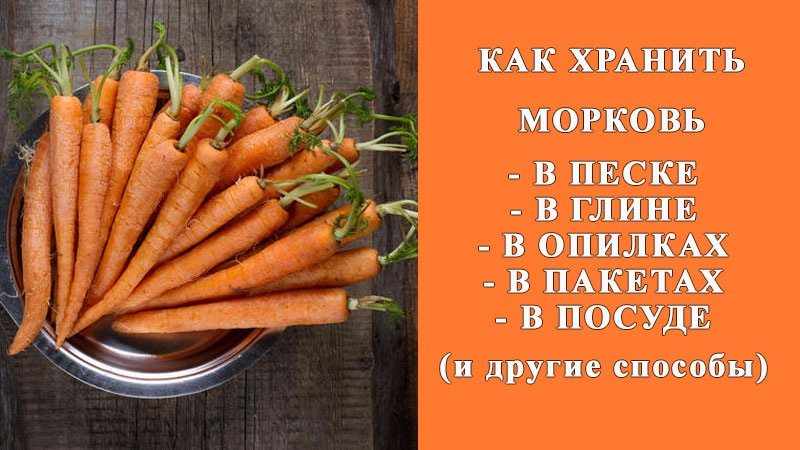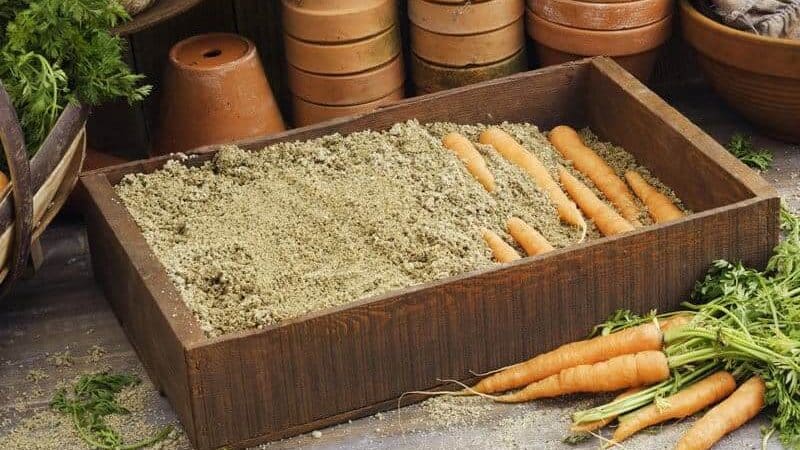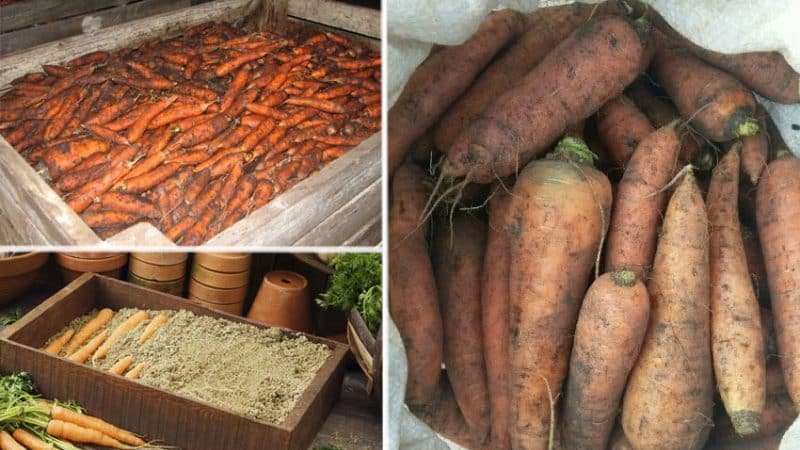The best ways to store carrots after harvest until spring
Preparing stocks of potatoes, carrots, beets, and onions is an annual tradition for many urban and rural residents. There are many ways to store vegetables, each of them has its own advantages and disadvantages.
In this article we will tell you how to store carrots so that they do not flabby or spoil, and remain fresh and tasty.
Selection and preparation of carrots for long-term storage

Factors that ensure a long shelf life of any root crop are the choice of a suitable variety, timely harvesting and compliance with storage conditions.
The ripening time of carrots depends on the variety. You can recognize it on the package with seeds. When planting in the spring, the day of harvest is calculated and marked on the calendar.
Advice. We recommend saving the seed packet. In case of a good harvest, it will become a reminder of a successful variety for the next year.
A root vegetable dug up too early will not accumulate the required amount of sugar - it will taste unsweetened.
Late digging results in an excess of sugar and amino acids. Overripe carrots can be smelled by mice and rats, which can spoil the harvest.
Advice. The color of the tops tells you that it's time to dig. If the lower leaves turn yellow, it means the carrots are ripe and can be harvested.
Experienced summer residents recommend not watering the beds the day before digging. Dry root vegetables will remain juicy for a long time.
After digging, the tops are cut off, as the leaves draw moisture from the fruit.
Pruning is carried out in two stages:
- Cut off the tops slightly above the head of the root crop.Dry the crop in the open air for 2-3 hours.
- Cut off the head by 0.5-1 cm and the tail.
After such preparation, it will not germinate in winter and the beneficial substances will not be absorbed into the sprouts. The root crop will remain strong and will not wilt.
After removing the tops, the vegetable is dried for another 3-4 hours. For the next 8-10 days, the crop is kept at a temperature of 10-14°C. The cut areas and damage caused by digging dry out. Rotten root vegetables will become visible - they are removed from the total mass.
Optimal storage conditions
The vegetable remains fresh for a long time if the following conditions are met:
- optimal humidity - 90-95%;
- temperature - 0...+1°С;
- air circulation.
These parameters are recommended to be observed when storing at home and on an industrial scale. Industrial premises are equipped with ventilation systems that ensure air circulation.
In storage facilities, carrots are placed in containers, pallets, boxes, and bags.
Best ways

Storing carrots at home for the winter requires the preparation of the necessary materials. Depending on where the root crops are kept in winter, a suitable method is chosen.
In sand
You will need wooden or plastic boxes, loamy sand, and water.
Advantages of loamy sand:
- reduces moisture evaporation;
- prevents the development of microbes;
- maintains a constant temperature.
Sand is moistened as follows: for one bucket of sand - 1 liter of water. A layer of sand 3-5 cm thick is poured into the container. Carrots are placed so that the root vegetables do not touch each other. Next is a layer of sand and again root vegetables, and so on until it is completely filled.
Important! Carrots will not survive in river sand.

In the sawdust
This is the Siberian way of preserving carrots.
The advantages of sawdust are based on the content of phytoncides in them, which:
- do not allow root crops to germinate;
- prevent the entry of bacteria.
Carrots are laid in layers, sprinkled with fresh sawdust.
In clay
Labor-intensive and time-consuming method. But the work is justified by the long shelf life - until the next harvest.
You need boxes or thick cardboard boxes, film, clay, water.
The method of storing in clay is compared to a cosmetic clay mask - as a result, the root vegetable does not fade.
Clay treatment before laying is done in two ways.

Pouring clay
Fill 0.5 buckets of clay with water. The next day, the swollen mass is mixed and refilled. Clay costs 3-4 days. It becomes like sour cream.
The bottom of the box is lined with film, vegetables are placed so that they do not touch each other. Fill with creamy mixture. Let it dry and lay out the next layer of vegetables. They fill it up. Alternate layers, not forgetting to dry each one, and so on until the top of the box.
Dipping in clay
For this method, garlic and clay mash are prepared. Clay mash: dilute the clay with water to such a state that it does not drip from the root vegetables. Garlic mash: pass 1 glass of garlic on a fine grater or through a meat grinder and dilute the mass in 2 liters of water.
Important! Prepare the mash in a well-ventilated area.
Unwashed carrots are dipped first into garlic and then into a clay mash. Lay out and dry.
Carrots in the “clay shell” state are placed in boxes or crates.
In the moss
This method is easy; if you buy moss in a store, it is already ready for use.
Forest experts collect this covering material themselves. A lot of time is spent processing it and preparing it for use.
For these purposes you will need sphagnum moss. It grows in deciduous forests.Because it turns from pale green to white when it dries, it is called “white moss.”
Advantages of moss:
- rich in nutrients;
- retains carbon dioxide well;
- retains moisture;
- has preservative properties;
- kills bacteria;
- easy.
Before storing, unwashed, dried carrots are kept in a cool place for a day. Alternating carrots and moss, lay the layers in boxes.
Important! Containers with carrots and moss are lighter than those with sand, clay or sawdust.
In onion skins
When organizing storage, husks are used like sawdust.
Essential oils of onion and garlic peels prevent the vegetable from rotting. They protect it from exposure to harmful bacteria.
In packages
Use plastic bags with a volume of 10-30 kg.
Unwashed, dried and trimmed carrots are placed in bags and not tied. Air humidity of 90-95% prevents the root crop from withering.
When the bags are opened, the carbon dioxide released from the carrots is small, but enough to prevent disease.
In a saucepan
Enameled pans with a volume of 10 liters or more are used for keeping vegetables in a cool place for a long time.
The carrots are washed and dried, the tops and tail are cut off. Place the root vegetables vertically, pressing them tightly against each other. Cover with a napkin and a lid. Vegetable containers are kept in the cellar.
On the beds
Experienced gardeners leave part of the harvest in the ground for the winter.
Step-by-step instructions for storing in beds:
- Cut off the tops.
- Cover the bed with wet coarse sand.
- Cover with film.
- Sprinkle sawdust, peat, humus or fallen leaves on top.
- Cover with roofing felt or another layer of film.
A bed of carrots covered in this way will withstand the cold, and the orange vegetable will delight you with its freshness and taste in the spring.
In cling film
The washed and trimmed carrots are wrapped in film so that the root vegetables do not touch each other. The film is not cut after each fruit, but several pieces are packed gradually.
Wrapped vegetables are stored in a cool place, such as a garage or basement.
Carrots will remain fresh for 1.5 months.
How to store carrots in an apartment

A refrigerator and an insulated balcony are suitable for storing carrots at home.
When the temperature changes in winter, it is important to ensure that it does not fall below 0°C on the balcony. The boxes are covered with dark material from the sun's rays.
It is convenient to store carrots on the balcony in boxes with sawdust or sand. When it is frosty, they are wrapped in a warm blanket. In extreme cold, they are moved to a warmer place or insulated even more.
In a private house, in a country house
The best option for storing vegetables is the underground of a house or cottage.
When building or purchasing housing on your own plot of land, pay attention to the quality of the underground space - it makes a convenient vegetable storage.
Before storing root crops, the storage area is prepared: the remains of the previous harvest are removed and ventilated. If necessary, disinfect the walls, wash the shelves and floor. Cleaning is done a month before planting vegetables, then aired for a long time.
Important! There must be a ventilation hole in the underground.
Store carrots in any way. Boxes and other containers are conveniently placed on lower shelves or on the floor.
In the basement, cellar

A basement is a room in any building that is half underground. It is called the first underground floor.
A cellar is a pit with reinforced walls and a covered top. In private houses, a cellar is called a basement in cases where the foundation of the house is made with a full floor.In village houses, the cellar has ordinary earth instead of a floor, and the walls are the foundation.
The difference in construction does not prevent these premises from having the same characteristics:
- maintaining optimal temperature - not lower than 0°C, humidity - 90-95%;
- air circulation.
In the refrigerator, freezer
Every refrigerator has containers for vegetables. They are located under the lower shelves. Carrots will be stored there for up to four months.
Two ways to keep root vegetables in the refrigerator:
- Wash, cut and dried carrots are stored in plastic bags. If water droplets appear on the bags, it is recommended to dry the vegetables and replace the bag with a dry one.
- Root vegetables are wrapped in a wet cotton towel and placed in the vegetable compartment.
A popular and convenient storage method is in the freezer. Housewives cut carrots for different dishes: into strips, into bars, and grate them on a coarse grater. This saves time during cooking in the future.
Before placing the chopped root vegetables in the refrigerator, they are blanched - scalded with boiling water. As a result, the action of enzymes slows down. The pieces do not lose their taste, color, or structure. Once frozen, blanched carrots retain their nutritional value until the next harvest.
The cooled crushed fruits are laid out on flat surfaces and placed in the freezer for 2 hours. Then they are placed in bags or containers and put in the freezer.
Maximum shelf life
It is possible to save carrots until the next harvest throughout the year. At home - when keeping root vegetables in clay or in the freezer. On an industrial scale, long-term storage is provided in special vegetable storage facilities.
During long transportation, vegetables become flabby, damaged, and are subject to changes in humidity and temperature. This negatively affects their further shelf life.
Read also:
Large carrot variety Red Giant.
Carrot hybrid for long-term storage Canada f1.
What to do if someone gnaws carrots in the ground and how to deal with them.
Useful tips
Carrots will keep well if:
- were imprisoned late varieties, intended for long-term storage;
- the harvest is harvested on time;
- vegetables are properly prepared for storage;
- a convenient storage method has been chosen;
- All conditions for maintaining root crops in winter have been met.
Conclusion
Keeping vegetables fresh helps us get vitamins and minerals year round. There are different ways to store them: they are not labor-intensive and not expensive. It all depends on how much harvest or purchased carrots need to be stored during the winter. With any method, it is important to remember the storage conditions: humidity, temperature and air circulation.